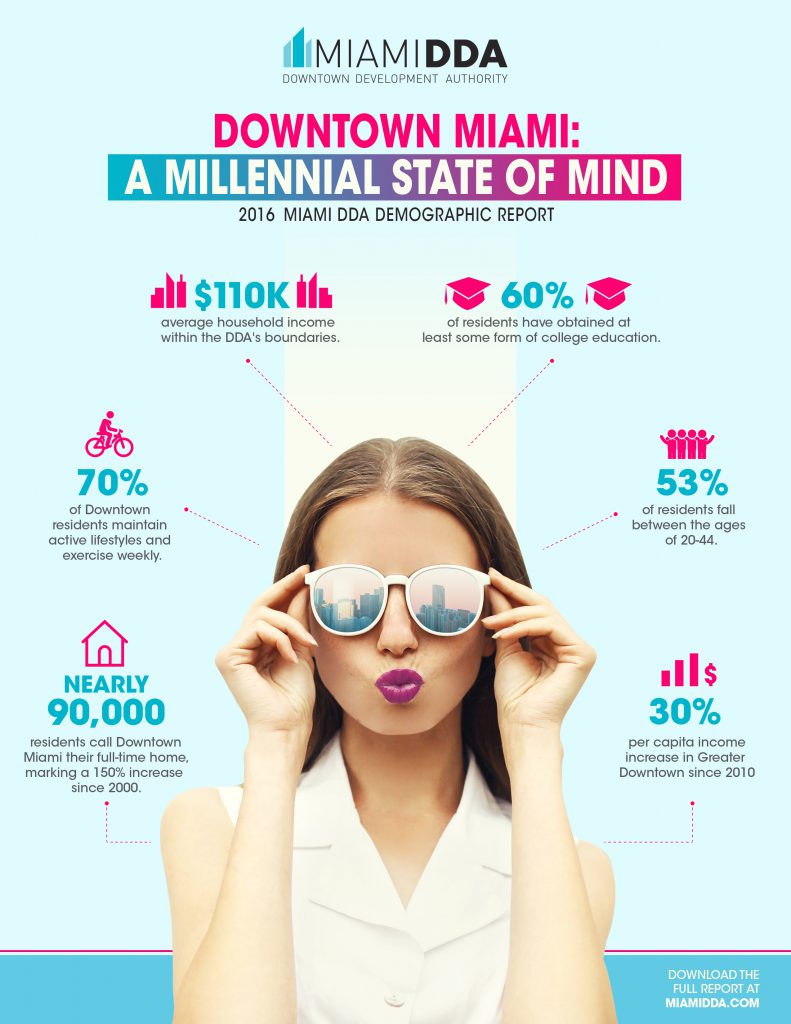Miami has long been criticized for overbuilding. 20,000 condo units were developed in the city’s urban core between 2005 and 2009 alone – double the amount built during the 40 years prior.
But according to the Miami Downtown Development Authority’s (Miami DDA) latest demographics study, this development has paved the way for a rapid migration of young professionals into the urban core.
Downtown Miami’s population has grown by 150% since 2000, with 90,000 people calling the urban core home. Roughly half of the area’s residents are between the ages of 20 and 44, a demographic shift that’s giving way to a community of highly-educated, health conscious, pet-friendly millennials.

All signs indicate this millennial migration won’t be slowing down anytime soon. The Miami DDA projects downtown’s population will surpass 100,000 by 2021.
Where will these young professionals live? 7,500 condo units and more than 5,500 apartments are now under construction in the urban core, and that may not even be enough.
As developers plan for the next millennial wave, trends for appealing to the changing demographics are beginning to emerge. Here’s a look at how Miami’s millennial migration is impacting real estate:
Market-rate rentals: Condo towers may be the dominant force in Miami’s residential market, but affordable apartments are crucial to attracting and keeping millennials. Melo Group‘s 38-story apartment building, Melody Tower, offers one-bedroom units at $1,650 per month. The building was fully leased upon opening. “We’re seeing strong demand from young people who can’t necessarily afford to buy a new luxury condo but still want to take advantage of everything Miami’s urban core has to offer,” said Carlos Melo of Melo Group. Nearby, Miami WorldCenter recently announced the addition of a market-rate rental component to its 27-acre footprint in the heart of downtown.
READ RELATED: MIAMI BASKS IN THE GLOW OF THE NEW YORK TIMES
Micro-apartments, popular in Manhattan and larger urban cores around the world, are making their way to Miami. Plans for Moishe Mana’s development on Flagler Street indicate that one-third of the project’s 328 apartments will be “micro,” meaning they offer less space at a lower price point. The idea is that residents are willing to sacrifice some space in exchange for balancing their budget and moving to a desirable neighborhood.
Transit-oriented development is becoming the cornerstone to all new development taking shape in and around Miami’s urban core. Downtown boasts the most extensive public transportation infrastructure in the southeast US, which creates opportunity for developers and their residents. Plans for the upcoming Brightline connecting Miami with Orlando will help attract more millennials looking to commute to and from downtown.
Elimination of parking saves development and real estate costs while appealing to millennials’ desire to forgive cars in favor of public transportation. Downtown Miami saw it’s first car-free building come on line earlier this year with Centro and more are in the works, including Moishe Mana’s Flagler Street project, which will only offer bike racks.
The days of developers building solely for wealthy buyers are giving way to a more diverse real estate economy that offers a balanced mix of product types and price points. As millennials grow their share of the residential market, these trends and more will continue shaping the look and feel of the ‘New Miami.’








 See More Blogs
See More Blogs
Comments